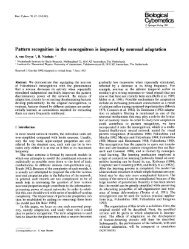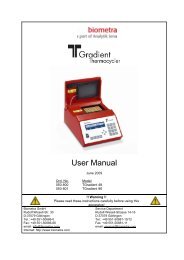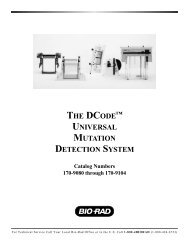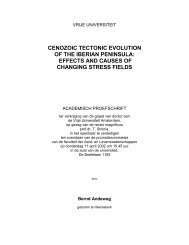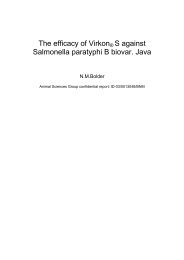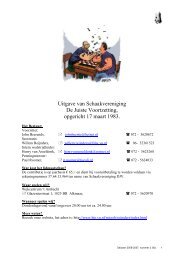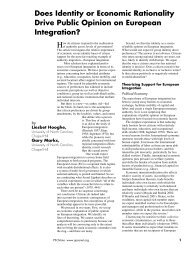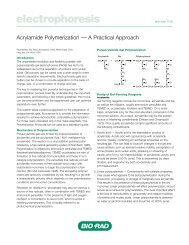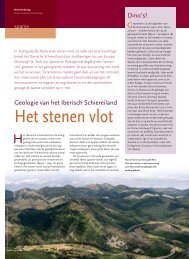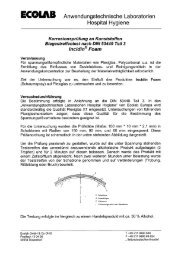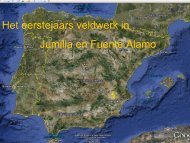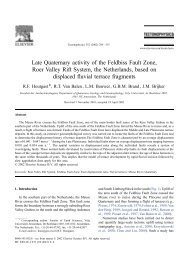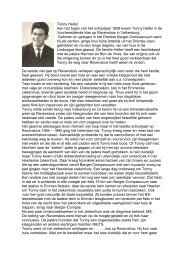5 NATURAL ABUNDANCE OF THE STABLE ISOTOPES ... - Falw.vu
5 NATURAL ABUNDANCE OF THE STABLE ISOTOPES ... - Falw.vu
5 NATURAL ABUNDANCE OF THE STABLE ISOTOPES ... - Falw.vu
Create successful ePaper yourself
Turn your PDF publications into a flip-book with our unique Google optimized e-Paper software.
Stable Isotopes of Hydrogen, Carbon and Oxygen7.2.3 REPORTING 18 O VARIATIONS AND <strong>THE</strong> 18 O STANDARDSOriginally 18 O/ 16 O of an arbitrary water sample was (indirectly, via a local laboratoryreference sample) compared to that of average seawater. This Standard Mean Ocean Water inreality never existed. Measurements on water samples from all oceans by Epstein and Mayeda(1953) were averaged and referred to a truly existing reference sample, NBS1, that timeavailable at the US National Bureau of Standards (NBS). In this way the isotope waterstandard, SMOW, became indirectly defined by Craig (1961a) as:18 NBS1 / SMOW = 7.94‰The International Atomic Energy Agency (IAEA), Section of Isotope Hydrology, in Vienna,Austria and the US National Institute of Standards and Technology (NIST, the former NBS)have now available for distribution batches of well preserved standard mean ocean water foruse as a standard for 18 O as well as for 2 H. This standard material, VSMOW, prepared byH.Craig to equal the former SMOW as closely as possible both for 18 and 2 , has beendecided by an IAEA panel in 1976 to replace the original SMOW in fixing the zero point ofthe 18 scale. All water samples are to be referred to this standard.From an extensive laboratory intercomparison it became clear that the difference between theearly SMOW and the present VSMOW is very small (IAEA, 1978), probably:18 SMOW / VSMOW = +0.05‰ (7.20)At present two standard materials are available for reporting 18 values, one for watersamples, one for carbonates. This situation arises from the practical fact that neither theisotope measurements on water nor those on carbonates are performed on the original materialitself, but are made on gaseous CO 2 reacted with or derived from the sample.The laboratory analysis of 18 O/ 16 O in water is performed by equilibrating a water sample withCO 2 of known isotopic composition at 25 o C (Sect.10.2.1), followed by mass spectrometricanalysis of this equilibrated CO 2 (Sect.11.1). This equilibration is generally carried out onbatches of water samples, consisting of the unknown samples (x) and the standard or one ormore reference samples. After the correction discussed in Sect.11.2.3.4 is made, it isirrelevant whether the water samples themselves are being related or the CO 2 samplesobtained after equilibration, provided sample and standard are treated under equal condition:18 x / VSMOW = 18 xg / VSMOWg (7.21)where g refers to the equilibrated and analysed CO 2 .The absolute 18 O/ 16 O ratio of VSMOW is reported as (2005.2 ± 0.45) x 10 -6 (Baertschi, 1976).Reference and intercomparison samples are available from the IAEA and the NIST. A surveyof the data is given in Table 11.2. In order to overcome small analytical errors, somelaboratories prefer to fix their VSMOW scale by two extreme points (Sect.11.2.3.5). Using107



